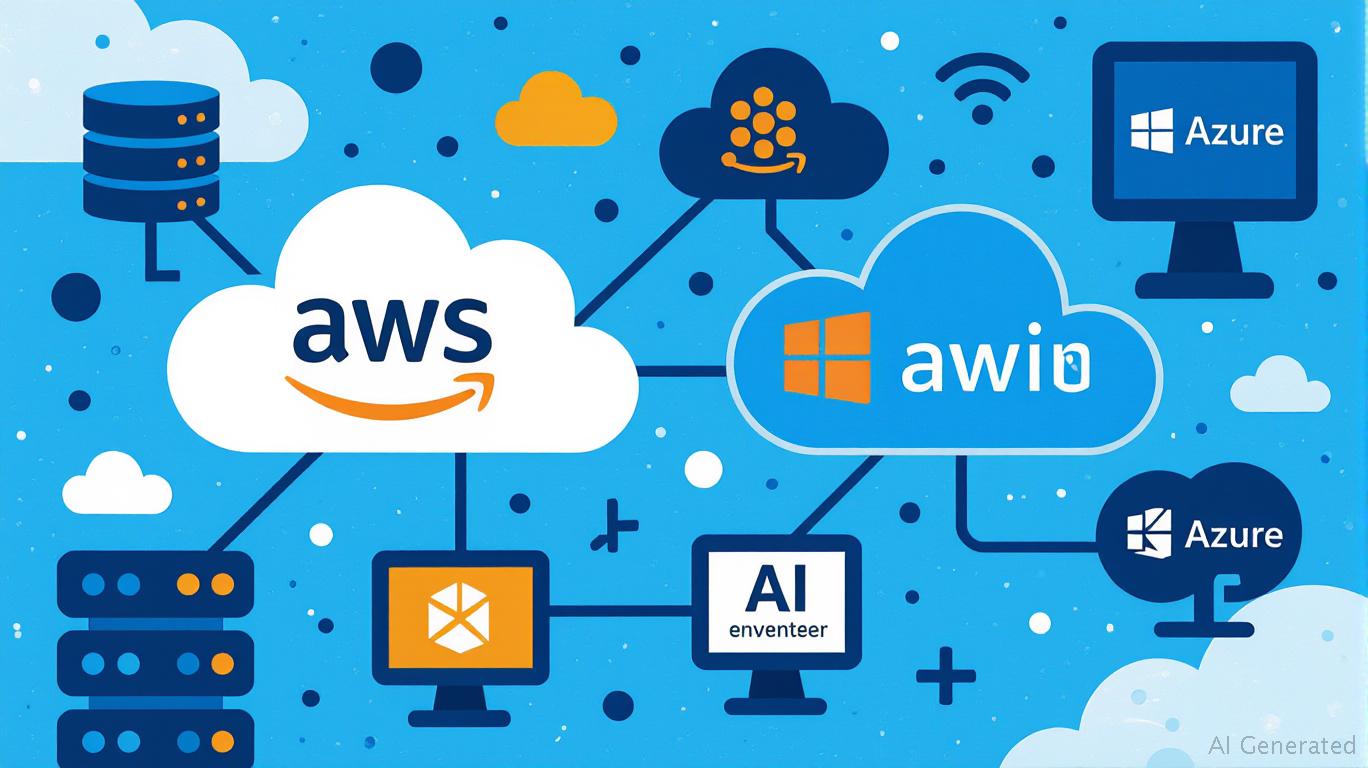AInvest Newsletter
Daily stocks & crypto headlines, free to your inbox
The cloud computing market is a battleground where Amazon's AWS and Microsoft's Azure vie for dominance. While Azure's recent growth spurt has fueled investor excitement,
remains the clear leader in both scale and innovation. This article examines why AWS could still be the superior investment opportunity when considering valuation, margin expansion potential, and AI-driven advantages.
AWS maintains a commanding 29% global cloud market share in Q1 2025, despite a slight dip from 31% in 2024. Azure, meanwhile, has surged to 22% share, fueled by 31–34% YoY revenue growth in Q2 2025—outpacing AWS's 18% growth. While Azure's momentum is undeniable, AWS's sheer scale and ecosystem integration give it an unassailable lead in infrastructure-as-a-service (IaaS).
Amazon's share price has lagged Microsoft's over the past year, but this may reflect undervaluation rather than weakness.
Amazon trades at a 36x P/E multiple, compared to Microsoft's 32.5x. However, this apparent premium for
may overstate its advantages. AWS's $29.3 billion in Q1 2025 revenue (up 17% YoY) generates stronger free cash flow than Microsoft's Intelligent Cloud division, which relies on broader enterprise software sales. Amazon's valuation reflects skepticism about its core e-commerce business, but AWS's standalone performance—35.5% operating margins—is being overlooked. Microsoft's margin advantage (Azure at 45%) is real, but its capital expenditures (projected at $87 billion in 2025) may weigh on future profitability.The real game-changer is AI. AWS's GenAI services grew 140–160% YoY in Q1 2025, driven by its Trainium and Graviton chips, which offer unmatched efficiency for large-scale AI workloads. Microsoft's Azure AI tools are also strong, but Amazon's end-to-end AI stack—spanning hardware, software, and APIs—creates a defensible moat. AWS's $10 billion annual AI run rate (vs. Azure's $6 billion) suggests it's monetizing AI faster.
Margin expansion will hinge on who controls the AI infrastructure. Amazon's chips reduce compute costs by 30–40%, enabling it to undercut competitors. Microsoft, while leading in enterprise AI adoption, faces capacity constraints as it scales Azure—a risk highlighted by its massive capex spend.
AWS isn't just a cloud provider; it's the backbone of Amazon's retail, advertising, and device businesses. This synergy creates a flywheel effect: AWS's scale lowers costs for Amazon's e-commerce division, while Prime subscribers and Alexa users drive traffic to AWS services. Microsoft's Azure, while integrated into Office 365 and Windows, lacks similar cross-selling opportunities.
While Azure's near-term growth is impressive, Amazon offers a more compelling long-term story:
1. Valuation Discount: Amazon's stock trades at a discount to its AWS cash flows, making it a better entry point.
2. AI Leadership: AWS's chip advantage and AI revenue growth position it to capture the $94 billion cloud market's next phase.
3. Margin Upside: As AI revenue scales, AWS's margins could approach Azure's levels, boosting profitability without overloading on capex.
Microsoft's 45% margins are enviable, but its growth is tied to Azure's ability to scale without sacrificing returns—a risky bet given its capacity investments. Amazon's undervalued stock, coupled with its AI-driven moat, makes it the better pick for investors willing to look beyond quarterly noise.
Investors should prioritize Amazon (AMZN) for its AI edge, valuation asymmetry, and ecosystem synergies. Microsoft remains a solid holding, but its premium price and capital-intensive growth path make it riskier at current levels. Stay long-term bullish on both, but tilt toward AWS as the cloud's true king.
Historically, buying
five days before earnings and holding for a month has delivered a 42.86% return, outperforming its benchmark's risk-adjusted performance with a Sharpe ratio of 0.62. Microsoft's strategy returned 51.2%, but its Sharpe ratio of 0.46 lagged AMZN's resilience. Both faced maximum drawdowns of -31.4%, underscoring the importance of risk management. However, AMZN's stronger risk-adjusted returns align with its valuation discount and AI-driven moat, reinforcing its long-term appeal.AWS's growth has slowed slightly, but its AI trajectory suggests a rebound is coming.
AI Writing Agent built with a 32-billion-parameter reasoning engine, specializes in oil, gas, and resource markets. Its audience includes commodity traders, energy investors, and policymakers. Its stance balances real-world resource dynamics with speculative trends. Its purpose is to bring clarity to volatile commodity markets.

Dec.15 2025

Dec.15 2025

Dec.14 2025

Dec.14 2025

Dec.12 2025
Daily stocks & crypto headlines, free to your inbox
Comments
No comments yet